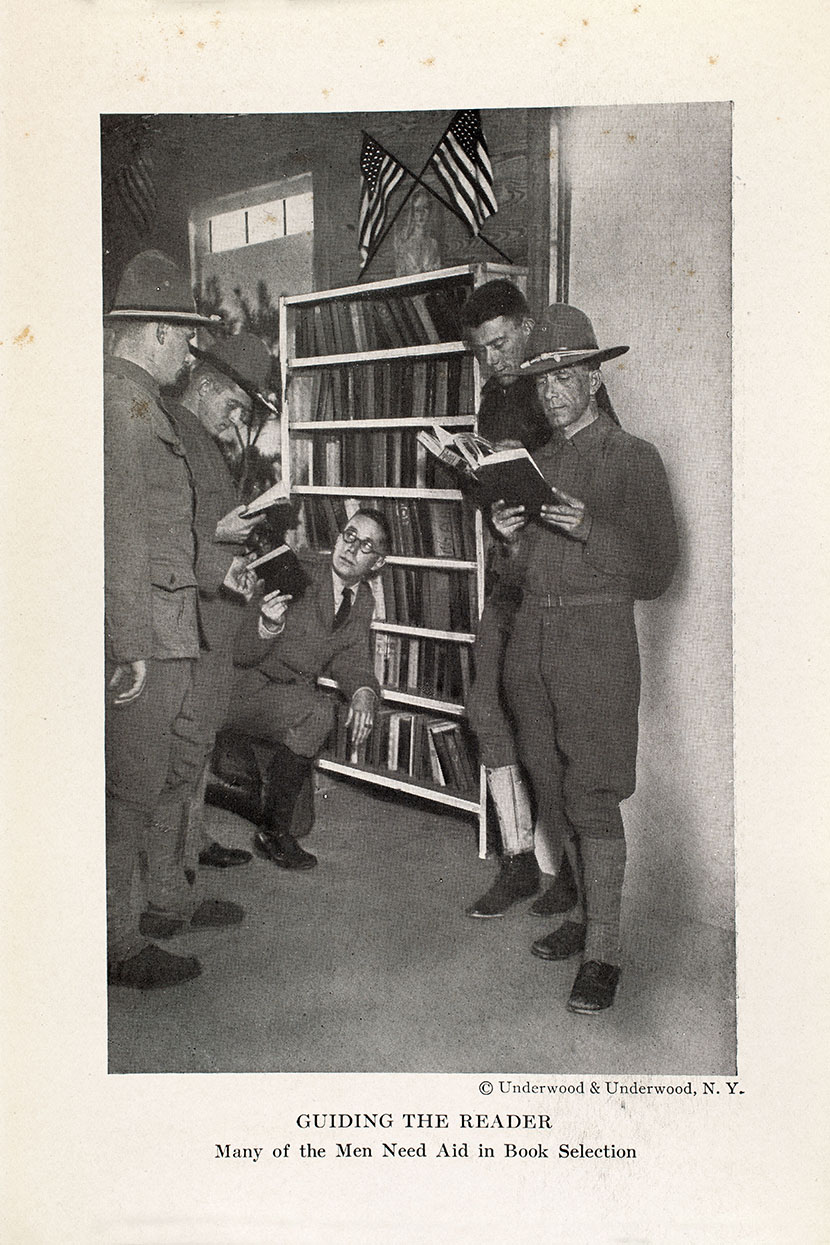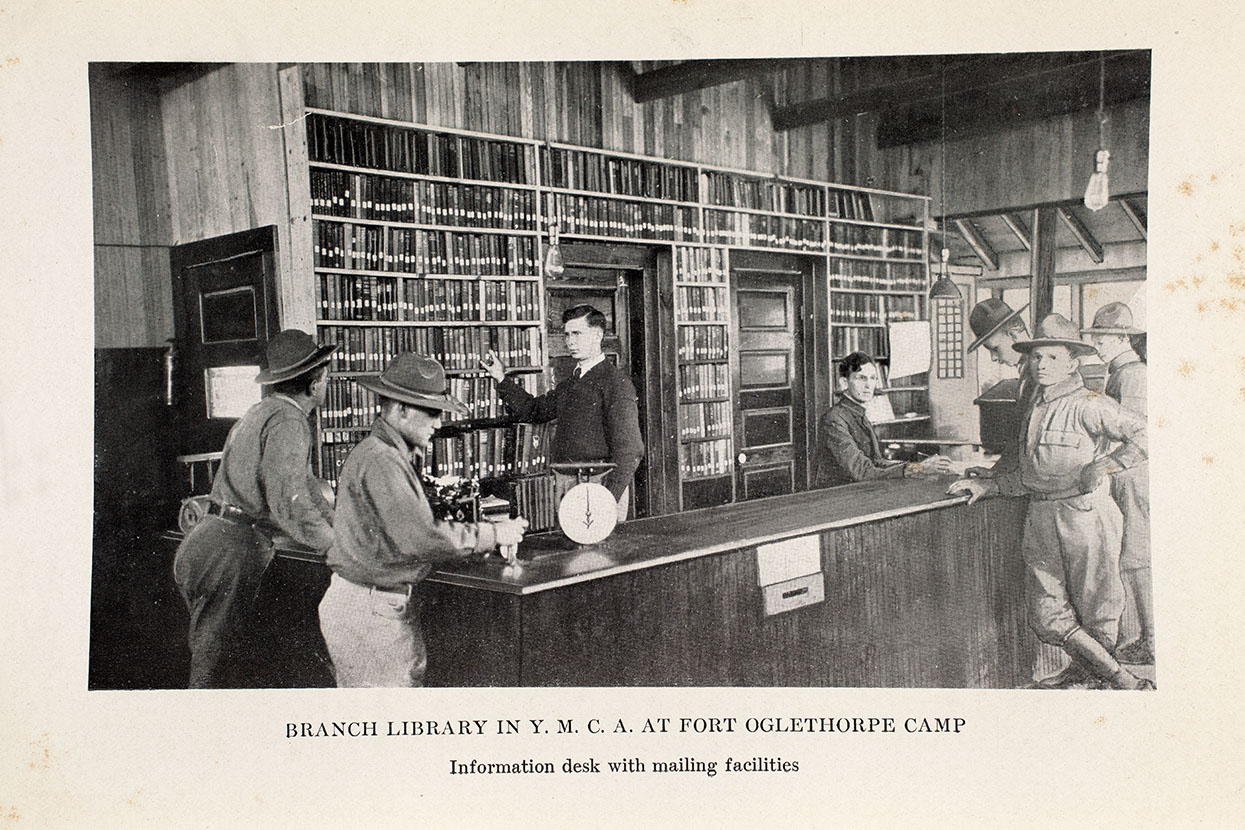The American Library Association’s training camp libraries in World War I
In observance of National Library Week (April 9-15) and the centenary of America’s entry into World War I in April 1917, this blog post explores the efforts of the American Library Association to provide books and periodicals to U.S. military forces during and after the First World War, especially here in Louisiana. The ALA operated under the auspices of the Commission on Training Camp Activities, an official government agency tasked with coordinating the work of private groups in providing recreational and educational services for soldiers in training camps. The ALA joined the Young Men’s Christian Association (YMCA), the Young Women’s Christian Association (YWCA), the Salvation Army, the Jewish Welfare Board, the Knights of Columbus, and the War Camp Community Service (formed by the Playground and Recreation Association of America) as the seven groups cooperating in this common mission.
The American Library Association formed its War Service Committee soon after the United States entered World War I to plan how to provide library services to soldiers and sailors both in training camps in the United States and on ships and at military bases overseas. In October 1917, at the committee’s request, the Library of Congress took over direction and control of the war service work because it was better able to manage the complex arrangements with the training camps and account for the considerable funds to be raised. Between 1917 and 1920, the ALA amassed five million dollars from public donations, erected thirty-six camp libraries, distributed some two million books and five million magazines, and provided services at more than five hundred locations by over one hundred librarians. Although over 300,000 books were purchased, most books and serials were donated by American citizens through their local public libraries. In addition to popular fiction and magazines, camp libraries stocked technical manuals, military training guides, religious tracts, reference books, foreign language materials, and vocational literature, testifying to the wide reading interests of American soldiers and sailors.
 Camp Beauregard was a U.S. Army training camp near Alexandria, Louisiana, that prepared men primarily from Louisiana, Mississippi, and Arkansas. Its camp library was organized by George F. Strong, the librarian of Adelbert College at Western Reserve University in Cleveland, Ohio, who spent the war years with the ALA’s Library War Service, eventually rising to become acting executive secretary of the service. He arrived at Camp Beauregard on October 1, 1917, finding 5,000 men but only 2,000 books, mostly from the New Orleans Public Library that had been put into circulation by the YMCA. The camp’s commander gave a company mess hall as the library’s temporary quarters. The library was organized quickly with the kitchen refitted into a workroom, the pantry employed as a bedroom, and the mess hall converted into a reading room by laying out books on the tables and benches.
Camp Beauregard was a U.S. Army training camp near Alexandria, Louisiana, that prepared men primarily from Louisiana, Mississippi, and Arkansas. Its camp library was organized by George F. Strong, the librarian of Adelbert College at Western Reserve University in Cleveland, Ohio, who spent the war years with the ALA’s Library War Service, eventually rising to become acting executive secretary of the service. He arrived at Camp Beauregard on October 1, 1917, finding 5,000 men but only 2,000 books, mostly from the New Orleans Public Library that had been put into circulation by the YMCA. The camp’s commander gave a company mess hall as the library’s temporary quarters. The library was organized quickly with the kitchen refitted into a workroom, the pantry employed as a bedroom, and the mess hall converted into a reading room by laying out books on the tables and benches.
Over the next six weeks the camp increased to 20,000 men and the library grew to 8,000 books (mostly works of popular fiction donated by the Chicago Public Library) and thousands of magazines. Strong established fourteen stations to distribute books around the camp, including five YMCA buildings, the Knights of Columbus hall, the base hospital, and four soldiers’ clubs in town. Soon after on November 12, the camp was quarantined for measles and pneumonia and the library ordered closed. Almost all the books were stored in the mess hall until the quarantine could be lifted, but the medical staff allowed for the non-returnable distribution of magazines to the sick by the YMCA. The epidemic clearly revealed the importance of providing library services to soldiers by their gratitude even for old, seemingly worthless magazines. George Strong observed, “I had never expected to see the dispersal among appreciative soldiers of the 10,000 apparently useless back numbers of magazines piled up in the Camp library.”
George Strong was transferred to Camp Bowie in Fort Worth, Texas, on November 20, leaving the Camp Beauregard library to a YMCA secretary. Samuel A. McKillop, Director of Extension at the Milwaukee Public Library, served as camp librarian in March and April 1918, at which time the camp finally constructed a dedicated library building, comparatively late for such a large training camp. The library had 10,000 books in camp by April and 14,000 by June 1918.
Several librarians from various parts of the country filtered in and out of Camp Beauregard during and after the war. William Marzolf and Lucy F. Rahn, who began working as library assistants in the spring of 1918, came on loan from the St. Paul (Minnesota) Public Library. Likewise, William F. Yust took a leave of absence from the Rochester (New York) Public Library to serve as librarian at three camps in the South, including Camp Beauregard where he found himself stationed at the end of the war.
On a related note, don’t forget to visit Hill Memorial Library’s current exhibit, Through the Valley of Death: A Special Collections Perspective on the First World War, on display from February 20 to June 2.
Sources:
Bulletin of the American Library Association 12 (November 1918): 500.
Koch, Theodore Wesley. Books in the War: The Romance of Library War Service (Boston: Houghton Mifflin, 1919)
_____. War Service of the American Library Association (Washington, D.C.: A.L.A. War Service, Library of Congress, 1918)
Library Journal 43 (February 1918): 102.
Public Libraries 23 (January 1918): 30-31.
Seven Year Survey of the Rochester Public Library, 1912-1919 (Rochester: Rochester Public Library, 1920), 33.
War Library Bulletin 1 (April 1918): 15-16.
War Library Bulletin 1 (June 1918): 4.
War Library Bulletin 1 (June 1918 sup.): 6-9.
Wisconsin Library Bulletin 14 (November 1918): 233-34.


